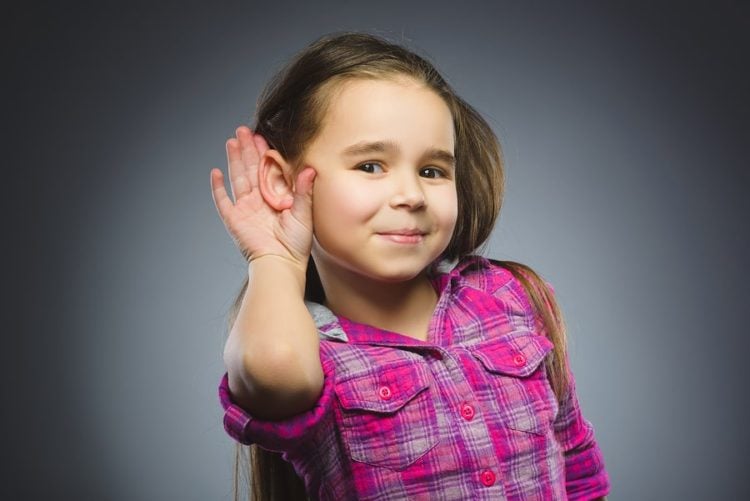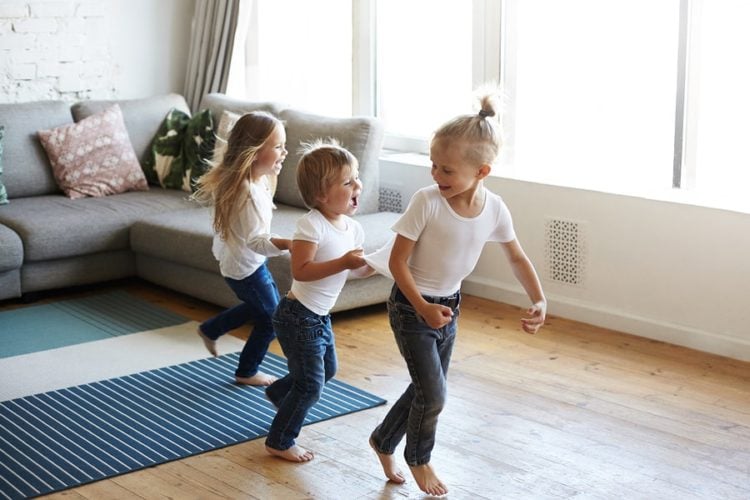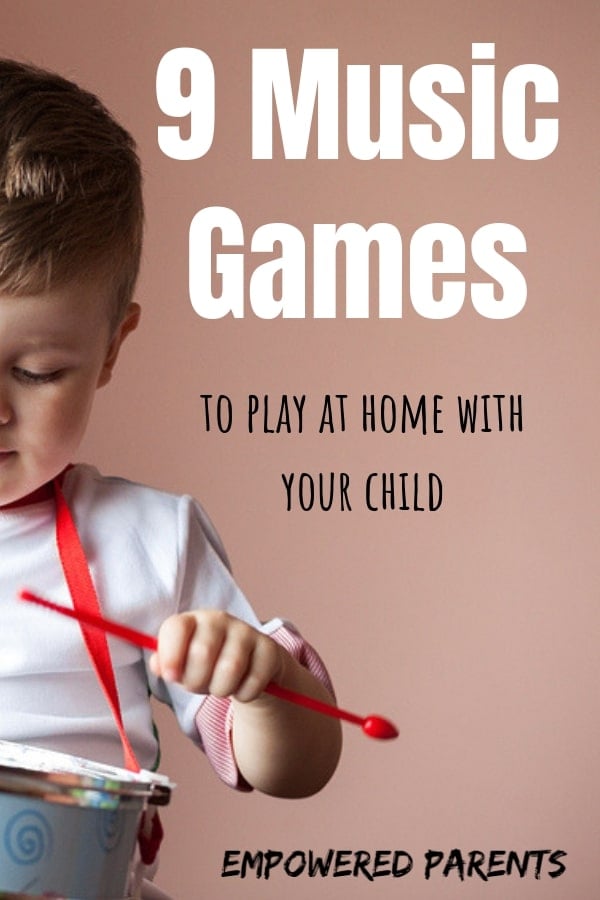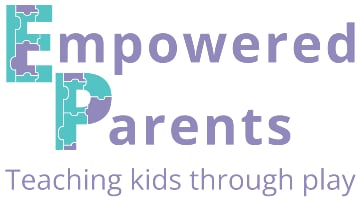Music is a wonderful activity for parents and teachers to engage in with children. It develops them physically, intellectually, socially and emotionally.
Here are 9 of the all-time best and easiest music games for kids. They require little to no prep or fuss. They are not complicated games with lots of rules, but small activities with big educational benefits.
1. Musical Statues and Musical Chairs
Musical Statues and Musical Chairs have always been my go-to music and movement activities as kids engage their whole body during the game.
They are also excellent games for developing auditory discrimination. Children have to listen carefully for the difference between sound and silence.
You can play Musical Statues with one child or a group, but Musical Chairs is best played with at least 3 or 4 family members or friends.
It is also one of the best music games for the classroom as you can involve many children.

I have listed both versions because they both work different motor skills so you should try them both out.
Musical Statues is great for developing control of the body and strengthening it while “freezing” in mid-air. It’s also a good first music game for toddlers.
Musical Chairs, on the other hand, teaches children to move through objects and space and get a sense of their position in space as they run around trying to find a chair to sit on, without bashing into others.
- Play music on a cd player or cell phone.
- While the music is playing, everyone dances around the room.
- Stop the music every now and then and everyone must freeze in the exact position they were dancing in when the music stopped.
- If you move, you are “out.” For young children, it is lots of fun to just keep freezing without anyone going “out”.
- Set out chairs around the room (one for each player).
- Play music on a cd player or cell phone.
- While the music is playing, everyone dances around the room.
- Remove one chair while everyone is dancing.
- Stop the music every now and then and everyone must run and sit on one of the chairs.
- Whoever didn’t get to a chair in time is “out”.
- Repeat, removing a chair each time until there are two people left and the one who sits on the remaining chair first is the winner.
2. Pass the Parcel
The Pass-the-Parcel Game is an old favourite traditionally played at birthday parties. Play it at home or in class and you will get your kids moving and listening carefully.
The best part is that children will be crossing the midline each time they pass the parcel along.
It can be played in two (passing back and forth), but if 3 or more play, then children will be crossing the midline as they pass from their left to their right and vice versa.
- Wrap any object (or small gift if it is a birthday party) into many layers of newspaper or wrapping paper. Make the layers easy to remove.
- Play music on a cd player or mobile phone.
- The parcel gets passed in a clockwise direction (teach your child this word while you’re at it!)
- When the music stops, the person holding the parcel can remove one layer of wrapping.
- When the music continues, the parcel keeps being passed around, until the music stops again and another layer is removed.
- The person who removes the final layer to reveal the parcel is the winner.
- Change direction for each new round (clockwise to anti-clockwise).
- Make sure the parcel is received with both hands and passed to the next person with both hands (to ensure crossing the midline).
3. One Little Elephant
Act out the song One Little Elephant. You’ll be teaching your kids to count and understand how numbers increase in value by 1 each time, and you’ll also be practising the important skill of balancing and walking in a straight line.
Here are the lyrics:
One little elephant balancing
Step by step on a piece of string
Thought it was such tremendous fun
That (insert name) called for another elephant to come
Two little elephants…
Three little elephants…
Four little elephants…
Five little elephants balancing
Step by step on a piece of string
Then the string broke and they all fell in
No more little elephants!
Listen to the tune here:
How to Play One Little Elephant:
- Lay a piece of string down on the floor.
- Start the game by being the first elephant to walk along the string, and use your arms to balance.
- Everyone sings the lyrics together.
- Pick a child to join you for the second verse and continue until all players are walking step-by-step on the string.
- For the last verse, the string breaks and you all collapse on the floor.
4. How Many Instruments Do You Hear?
In this game, the object is to listen to and identify different instruments. Children will need to have had some exposure to instruments to recognize the basic ones.

You can also play clippings of instruments on YouTube to teach kids some of them, but real-life instruments will be far more meaningful.
How to Play ‘How Many Instruments Do You Hear?‘
- Play a song on any device.
- Choose a song with various instruments in it (try to search on YouTube for the instrumental version of songs).
- Draw the instruments you hear on a sheet of paper.
- At the end of the song, compare drawings and see what instruments were heard.
5. Match the Sounds
For this activity, you will need a variety of basic instruments (or even handmade or improvised instruments).
The objective is to listen to the music and try to find appropriate instruments that match or pair well with the sound.
Some examples:
- Hitting a triangle (or two pieces of cutlery together) for small, high sounds
- Banging on drums or a box for a slow, deep voice
- Banging cymbals together (or pot lids) for a loud, high voice
- Shaking bells or a tambourine for fast music
There are no rules here. Demonstrate a song first by making suggestions about what items could match the sounds and ask for your children’s input. Then play songs and let them freely play their choices to the music.
6. Draw the Music
In this activity, children quite literally draw the music as they hear it.
Provide large pieces of paper and pencils or wax crayons and ask your children to draw what they hear.
They could draw:
- How the music makes them feel
- Wavy lines or zig-zags to represent slow, flowing music or fast, choppy music
- The beats they hear (e.g. draw short and long lines for short and long sounds)
Keep this totally open and allow your kids to surprise you with how they interpret and draw the music. Draw your own interpretation at the same time and see how your pictures differ.
7. Hide and Listen
This game is about hearing the volume and making the correct associations (loud means close and soft means far).
How to Play Hide and Listen:
- Play this game with one child or a small group.
- Blindfold children and hide any instrument (such as a tambourine) somewhere in the room where you are playing.
- Tell them what instrument they must find.
- They then search for the instrument while you play music in the background.
- Explain that when the music gets softer they are going further from the instrument and when it gets louder they are getting closer to it.
8. Dance to the song
This game involves using the whole body and using actions and props to represent the music.

How to Play Dance to the Song:
- Use props such as scarves, streamers, ribbons, sticks to bang together, etc.
- Use your body to make sounds – stamp feet, click fingers, clap hands, march, tiptoe, etc.
- Play different types of songs – nursery rhymes, classical music, pop songs from the radio, etc.
- Dance freely together and let the creative juices flow by using props.
- A classical song could work well with a scarf or ribbon, an upbeat song could be clapped to or the sticks could be banged together, a nursery rhyme could be marched to (e.g. The ants go marching), etc.
- Demonstrate some examples and ask your kids to make up some of their own.
- Finally, choreograph your own song together with instruments, props and movements.
9. Let’s Make Up the Words
This last activity is extra challenging as you will be teaching your children about rhyme as well as rhythm.
How to Play Let’s Make Up the Words:
- Choose a well-known nursery rhyme with a fairly easy melody, such as Baa-baa black sheep.
- Make up a new name for the rhyme together.
- Taking turns and going line-by-line, make up new words for the song.
- Try to get the lines to rhyme in pairs.
- Try to match the rhythm of the song (e.g. My-name-is-A-me-li-a, My-bro-ther-is-much-ol-der).
And there you have it, 9 very easy music games for children!
Read more about the benefits of music in early childhood.


Deury Nixan
Friday 25th of August 2023
you made me relax from preparing lessons. I am always thankful for you. lots of love from srilanka
Tanja Mcilroy
Friday 25th of August 2023
Thanks for letting me know! I'm glad you enjoyed this.
Levi Malone
Thursday 20th of October 2022
It is so good and I like it too you are good at it.
Tanja Mcilroy
Monday 24th of October 2022
I'm glad you like these, Levi!
Nyasha
Monday 19th of September 2022
I love everything its so educational end involving. I wish every parent had access to this information. Thank you so much for such initiative
Tanja Mcilroy
Monday 19th of September 2022
Thanks, Nyasha! So pleased you're enjoying the content.
Rock Out Loud
Saturday 2nd of October 2021
Like all these music games ideas to help kids learn new skills! Thank you for sharing this useful post!
Tanja Mcilroy
Monday 4th of October 2021
I'm glad you enjoyed these!
adip,
Wednesday 28th of July 2021
very very god for the development of a child. thanks lots.
Tanja Mcilroy
Wednesday 28th of July 2021
Thank you, Adip!